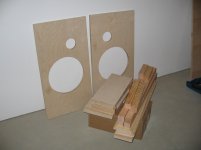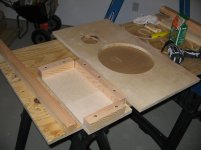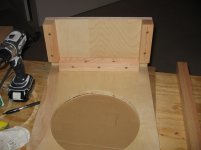Manzanita component variables
Liasom:
Great to hear of your plans to build the Manzanita!
All three of your questions boil down to what is the best value for R2, the Vifa pad resistor. The changes you are considering for L1 and L2 are minor enough that to accommodate them, a simple adjustment of R2 should be sufficient to bring the system into tonal balance.
What I recommend is you purchase two each 3.7, 4.0, 4.7 and 5.1 ohm resistors and see what sounds best to you. (Parts Express DNR series standard values at $1.25 each will work just fine) Ideally one would also like to have a 5.6, 6.0 and 6.2 MFD cap selection for C1. But given the good phase tracking and fairly low acoustic crossover frequency, the C1 value is not all that important. R2's value is.
If you can't justify buying all of the above R2 values, I would just stick with, or at least start with 4.0 ohms for R2. One additional thing to remember is that having the extra resistor values available will also allow you to adjust the systems tonal balance to reflect your personal taste as well as the environmental conditions where you listen.
A third place for adjustment can be R1, the trap bypass resistor. Values of around 6, 8, 10 & 15 can be used to effect. Not necessarily recommending this, just an FYI for those who like to experiment. Higher values tend to lower the treble output a bit.
Hope the above helps you with this project!
John
Liasom:
Great to hear of your plans to build the Manzanita!
All three of your questions boil down to what is the best value for R2, the Vifa pad resistor. The changes you are considering for L1 and L2 are minor enough that to accommodate them, a simple adjustment of R2 should be sufficient to bring the system into tonal balance.
What I recommend is you purchase two each 3.7, 4.0, 4.7 and 5.1 ohm resistors and see what sounds best to you. (Parts Express DNR series standard values at $1.25 each will work just fine) Ideally one would also like to have a 5.6, 6.0 and 6.2 MFD cap selection for C1. But given the good phase tracking and fairly low acoustic crossover frequency, the C1 value is not all that important. R2's value is.
If you can't justify buying all of the above R2 values, I would just stick with, or at least start with 4.0 ohms for R2. One additional thing to remember is that having the extra resistor values available will also allow you to adjust the systems tonal balance to reflect your personal taste as well as the environmental conditions where you listen.
A third place for adjustment can be R1, the trap bypass resistor. Values of around 6, 8, 10 & 15 can be used to effect. Not necessarily recommending this, just an FYI for those who like to experiment. Higher values tend to lower the treble output a bit.
Hope the above helps you with this project!
John
Thanks, John!
Taking into account your recommendations for R2 and C1, and deciding to leave out the R1 trap bypass resistor tweaks, I've made up a couple of BOMs to see what I could do about lowering the cost to minimum when compared to Pano's BOMs.
I've sourced from PE and ERSE. If I can find someone in the Dallas area that wants to go in with me to build two pairs, the component cost is about $291 a pair due to the Peerless 830669 dropping from $97.60 to $89.30 each when the quantity is 4 or more. Without that the cost is about $313 a pair.
Here are the BOMs, only catch is that ERSE may have some product on backorder. Have to contact them to see about that.
1 buyer
ERSE 1 pair 107 kB PDF
PE 1 pair 141 kB PDF
2 buyers
ERSE 2 pairs 108 kB PDF
PE 2 pairs 141 kB PDF
So if you're in the Dallas area and want to go in for a pair using these BOMs let me know and we can work something out.
Taking into account your recommendations for R2 and C1, and deciding to leave out the R1 trap bypass resistor tweaks, I've made up a couple of BOMs to see what I could do about lowering the cost to minimum when compared to Pano's BOMs.
I've sourced from PE and ERSE. If I can find someone in the Dallas area that wants to go in with me to build two pairs, the component cost is about $291 a pair due to the Peerless 830669 dropping from $97.60 to $89.30 each when the quantity is 4 or more. Without that the cost is about $313 a pair.
Here are the BOMs, only catch is that ERSE may have some product on backorder. Have to contact them to see about that.
1 buyer
ERSE 1 pair 107 kB PDF
PE 1 pair 141 kB PDF
2 buyers
ERSE 2 pairs 108 kB PDF
PE 2 pairs 141 kB PDF
So if you're in the Dallas area and want to go in for a pair using these BOMs let me know and we can work something out.
Last edited:
Hello,
I’m planning on building this speaker project (my first) in a couple weeks time. I was wondering if the speakers used have any special break in procedure. Without opening a can of worms regarding the breaking in various audio products, the reason I ask is because I also purchased some Mark Audio speakers which the manufacturer mandates running in at low volumes for a certain amount of time before cranking it up.
Thanks.
Robert
I’m planning on building this speaker project (my first) in a couple weeks time. I was wondering if the speakers used have any special break in procedure. Without opening a can of worms regarding the breaking in various audio products, the reason I ask is because I also purchased some Mark Audio speakers which the manufacturer mandates running in at low volumes for a certain amount of time before cranking it up.
Thanks.
Robert
Breakin
Good question. Both of the Manzanita drivers are OK from the get-go.
In the Mark Audio situation you sight, break in would be needed to get the driver to it's long term performance point.
Since the Manzanita crossover is all ready established based on several mature (seasoned) driver sets, and, with the Peerless & Vifa being very consistent, we do not need to go through a breakin period to find where their T/S parameters end up.
Other than out right abuse, both of these drivers are very stable and will perform well for many years. As with nearly all drivers, they will improve with time. 100 hours of general use will settle them down.
John
Good question. Both of the Manzanita drivers are OK from the get-go.
In the Mark Audio situation you sight, break in would be needed to get the driver to it's long term performance point.
Since the Manzanita crossover is all ready established based on several mature (seasoned) driver sets, and, with the Peerless & Vifa being very consistent, we do not need to go through a breakin period to find where their T/S parameters end up.
Other than out right abuse, both of these drivers are very stable and will perform well for many years. As with nearly all drivers, they will improve with time. 100 hours of general use will settle them down.
John
Erse has really good prices and I have considered ordering from them directly. However, P.E. offers free shipping (in the lower 48) for orders over $98, which is often the deal maker. Take that into consideration.
Thanks for sharing your BOM and source. All look spot on for a good build.
Thanks Pano and John. Life got ugly last Saturday -- I got home in the afternoon and the hot water heater was leaking.
 So, a large amount of money spent, I have a new hot water heater instead of a plan to purchase components for a pair of Manzanitas. I will make this happen someday! Hopefully soon.
So, a large amount of money spent, I have a new hot water heater instead of a plan to purchase components for a pair of Manzanitas. I will make this happen someday! Hopefully soon.Manzanita power requirements
This has always been the main concern with the Manzanita. It is an easy load from an impedance and phase standpoint, but with a net efficiency in the 82-84 dbw it is power hungry. The Manzanita can handle 100 watts or more of nominal program material. ie, music.
If you want to play at live levels in a large room the F5 is not the answer. However if you mostly listen to jazz, vocals, (guy or girl with guitar), light to moderate classical at a listening distance of 8'-10' in a small to medium sized room, say 12' x 18' with 8' ceilings the 25 wpc or so the F5 delivers should be quite nice.
This has always been the main concern with the Manzanita. It is an easy load from an impedance and phase standpoint, but with a net efficiency in the 82-84 dbw it is power hungry. The Manzanita can handle 100 watts or more of nominal program material. ie, music.
If you want to play at live levels in a large room the F5 is not the answer. However if you mostly listen to jazz, vocals, (guy or girl with guitar), light to moderate classical at a listening distance of 8'-10' in a small to medium sized room, say 12' x 18' with 8' ceilings the 25 wpc or so the F5 delivers should be quite nice.
Manzanita efficiency comments
The simple answer is yes, you can make it more efficient.
In the realm of small OB designs, small being relative, you set performance goals and make choices. The big choice with the Manzanita was the deepest practical bass extension given the baffle size. Using a baffle area similar to the Manzanita OB (mainly width & wing depth), you need to strike a balance between bass extension and efficiency. And there is always cost and complexity lurking in the background too.
There are much higher efficiency 12" class drivers available and a couple have enough midrange extension to mate up with the Vifa. But soon you run into the efficiency limits of the Vifa. For arguments sake, let's stick with the excellent Vifa for the HF component and retain the Manzanita baffle. The best we can hope for would be around 86 dbw, maybe slightly more. Keep in mind about 4 of the 86 db is from rear reflected energy. And we would need to trade away half an octave of bass response while paying at least twice as much money for a high quality, lower Q higher efficiency woofer. Half an octave doesn't seem like much, but a speaker with an F3 around 60 Hz is a lot different than one with an F3 of 40 Hz!! And, a complete crossover redesign would also be required.
We can add a monopole, dipole or cardioid format sub woofer to get the lost half octave (and then some) back. However, at that point we have moved far away from the original design goals of the Manzanita. Cost, complexity and other design elements are now very different. As usual, the Iron Law remains in place, no free lunch!!
So, to meet my initial Manzanita goals of a simple, low cost, plug and play (passive) OB with flat bass extension into the upper 30's operating at a rear wall distance of 30"-48", efficiency was the major trade off.
FYI, I have developed a much higher efficiency version of the Manzanita I call the HE. But... it uses a 18" cast frame pro woofer, a very expensive cast frame Seas 8" full range, a much larger baffle and way more complex crossover. And with all that it does not reach quite as far down as the Manzanita. 14 db more efficient which is nice, but a way different animal.
The simple answer is yes, you can make it more efficient.
In the realm of small OB designs, small being relative, you set performance goals and make choices. The big choice with the Manzanita was the deepest practical bass extension given the baffle size. Using a baffle area similar to the Manzanita OB (mainly width & wing depth), you need to strike a balance between bass extension and efficiency. And there is always cost and complexity lurking in the background too.
There are much higher efficiency 12" class drivers available and a couple have enough midrange extension to mate up with the Vifa. But soon you run into the efficiency limits of the Vifa. For arguments sake, let's stick with the excellent Vifa for the HF component and retain the Manzanita baffle. The best we can hope for would be around 86 dbw, maybe slightly more. Keep in mind about 4 of the 86 db is from rear reflected energy. And we would need to trade away half an octave of bass response while paying at least twice as much money for a high quality, lower Q higher efficiency woofer. Half an octave doesn't seem like much, but a speaker with an F3 around 60 Hz is a lot different than one with an F3 of 40 Hz!! And, a complete crossover redesign would also be required.
We can add a monopole, dipole or cardioid format sub woofer to get the lost half octave (and then some) back. However, at that point we have moved far away from the original design goals of the Manzanita. Cost, complexity and other design elements are now very different. As usual, the Iron Law remains in place, no free lunch!!
So, to meet my initial Manzanita goals of a simple, low cost, plug and play (passive) OB with flat bass extension into the upper 30's operating at a rear wall distance of 30"-48", efficiency was the major trade off.
FYI, I have developed a much higher efficiency version of the Manzanita I call the HE. But... it uses a 18" cast frame pro woofer, a very expensive cast frame Seas 8" full range, a much larger baffle and way more complex crossover. And with all that it does not reach quite as far down as the Manzanita. 14 db more efficient which is nice, but a way different animal.
I started building a pair of these speakers over the weekend. Its my first attempt at building speakers. I decided to take a few pictures along the way. If anyone is interested I could post and describe my experience. I can't offer much in the way of measured performance as I don't have any of that type of gear. Thanks to John for putting all his insight out there.
Robert
Robert
I started building a pair of these speakers over the weekend. Its my first attempt at building speakers. I decided to take a few pictures along the way. If anyone is interested I could post and describe my experience. I can't offer much in the way of measured performance as I don't have any of that type of gear. Thanks to John for putting all his insight out there.
Robert
Looking forward to this!
Parts ready to build. I have a portable table saw so it makes things workable. All the lumber came from my local depot. The birch plywood for the baffle is alright I guess. The top piece on the stack was flat enough and wasn’t dented or otherwise so I took it. I was by myself and wasn’t prepared to go through the stack. Couldn’t find straight 2 X 2 (so I found a straight 2 x 4) and cut the supports for the wings and baffle on my saw. The wings are cut from 6 inch plywood. I don’t know why my new router bit burned the plywood a bit when making the speaker cutouts. I took it in three cuts and went real easy.
Attachments
- Home
- Loudspeakers
- Multi-Way
- Fast, fun, Inexpensive OB project



